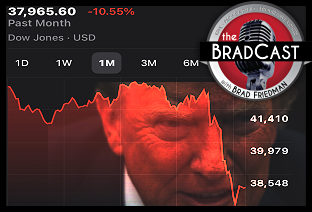 On today's BradCast: I'm back! With huge thanks to Angie Coiro for filling in for us over the past week! But, if you thought the June 20th U.S. House Special Election in Georgia's 6th District was over, well, it's not quite yet, as our guest today, one of the plaintiffs in the Election Contest filed last week in state court, seeking to overturn the results, makes clear. [Audio link to show is posted below.]
On today's BradCast: I'm back! With huge thanks to Angie Coiro for filling in for us over the past week! But, if you thought the June 20th U.S. House Special Election in Georgia's 6th District was over, well, it's not quite yet, as our guest today, one of the plaintiffs in the Election Contest filed last week in state court, seeking to overturn the results, makes clear. [Audio link to show is posted below.]
But first, the G-20 Summit which wrapped up over the weekend in Hamburg, Germany made very clear that it is now the U.S. (or, more accurately, the Trump Administration) against the world. Old allies like Germany, France and Great Britain are forming new alliances with nations like China, to move ahead without the U.S. in the wake of the Trump Administration's plan to pull out of the landmark Paris Climate Agreement to curb the man-made release of greenhouse gases that cause global warming.
Meanwhile, back here at home, Democrats continue to wring their hands about what they believe to be a hacked or otherwise manipulated Presidential election in 2016, even while failing to do anything about voting systems that are easily hacked, manipulated and otherwise 100% unverifiable.
With major security concerns about last month's U.S. House Special Election in Georgia's 6th Congressional District --- where Democrat Jon Ossoff reportedly lost to Republican Karen Handel by 4 points after leading in virtually all of the pre-election polls --- you'd think Dems would be raising holy hell about the fact that Georgia still uses 100% unverifiable voting systems. That is particularly alarming in Georgia, since the state was recently discovered to have kept the passwords for those easily-manipulated 100% unverifiable Diebold touch-screen voting systems (along with the state Voter Registration databases and much more) on a completely unprotected web server for at least 7 months between August of last year and March of this year. The revelation regarding the massive security breach reported just days before the June 20 election at Kennesaw State University --- which has long been contracted to program all of the state's voting, tabulation and voter registration systems. That breach, we have since learned, only became known after the data was found and downloaded by at least two different cybersecurity researchers in those seven months.
But while the DNC seems to be "moving on" despite the unverifiable reported results of the the most expensive U.S. House race in history (in which the only verifiable votes in the race, the paper absentee ballots, reported Ossoff defeating Handel by a nearly 2 to 1 margin), a multi-partisan group of voters in the state of Georgia has now filed an election contest [PDF] in court, seeking to void the results and hold a new election on verifiable paper ballots.
I'm joined today by one of the plaintiffs in the suit, MARILYN MARKS, a former Republican candidate for office, longtime election integrity advocate, and Executive Director of the Coalition for Good Governance. We discuss the group's legal complaint, why they are filing it, what they hope to achieve, and if the GOP-majority House of Representatives will move to have her case tossed out of court on Constitutional jurisdictional grounds (as has been the case in similar Election Contests in recent history.)
The state's unverifiable equipment should lead the court to void the results of election, she argues, since it "absolutely cannot meet Georgia's statutes right now and it cannot be used going forward, not even in the municipal elections coming up in November."
Moreover, Marks explains, "we are asking that the court order Sec. of State [Brian] Kemp to re-examine the equipment, just as citizens [and more than two dozen world class computer scientists and e-voting experts] had asked back in May, before the June election...He refused."
She adds that "we want to see these paperless, unverifiable, anybody's-guess-who-won equipment gone from Georgia," and by "we" she means a coalition of Democrats, Republicans and the head of the far-right Constitution Party, who are plaintiffs in the suit. "We have members of our Coalition for Good Governance who literally also campaigned for Karen Handel, who very much support this lawsuit. So, it wasn't just about winning. They believe we're doing the right thing, even though it may very well overturn their candidate's victory. "
"Georgia is the poster child for unbelievably lax security and inviting in, with a welcome mat, any bad actors who want to walk in. Our experts have said...one after the other after the other, 'Look, the security is so lax in Georgia that you must presume the system has been compromised, you cannot rely on the votes coming out of these machines,'" Marks tells me.
But will Congress intercede to block the suit, as they have in the past after the declared winner has already been seated? (See their letter from 2006 here [PDF] that resulted in a contested U.S. House election in CA being dismissed by the court.) And why, by the way, are Democrats (and Republicans, for that matter) so resistant to stand up and demand elections and results that are overseeable by the public? I discuss all of that and much more with Marks today...
(Snail mail support to "Brad Friedman, 7095 Hollywood Blvd., #594 Los Angeles, CA 90028" always welcome too!)
|


 Blowing Smoke.
Blowing Smoke. 'Green News Report' 5/6/25
'Green News Report' 5/6/25
 SCOTUS Allowing Publicly-Funded Religious Schools 'Would be a Ground-Breaking Disaster': 'BradCast' 5/7/25
SCOTUS Allowing Publicly-Funded Religious Schools 'Would be a Ground-Breaking Disaster': 'BradCast' 5/7/25 Trump Judge Blocks NC GOP Attempt to Steal 2024 State Supreme Court Election: 'BradCast' 5/6/25
Trump Judge Blocks NC GOP Attempt to Steal 2024 State Supreme Court Election: 'BradCast' 5/6/25 Prosecutors Resign After Trump U.S. Attny Strikes Deal With Felon Cop: 'BradCast' 5/5/25
Prosecutors Resign After Trump U.S. Attny Strikes Deal With Felon Cop: 'BradCast' 5/5/25 Sunday 'Good Buy, Dolly!' Toons
Sunday 'Good Buy, Dolly!' Toons Trump Losing Streak Continues into SECOND Hundred Days: 'BradCast' 5/1/25
Trump Losing Streak Continues into SECOND Hundred Days: 'BradCast' 5/1/25 'Green News Report' 5/1/25
'Green News Report' 5/1/25 100 Daze: 'BradCast' 4/30/25
100 Daze: 'BradCast' 4/30/25 Campaign to 'Impeach Trump Again' Gains Fresh Momentum: 'BradCast' 4/29/25
Campaign to 'Impeach Trump Again' Gains Fresh Momentum: 'BradCast' 4/29/25 'Green News Report' 4/29/25
'Green News Report' 4/29/25 And Then They Came for the Judges...: 'BradCast' 4/28/25
And Then They Came for the Judges...: 'BradCast' 4/28/25 Sunday 'Desperation' Toons
Sunday 'Desperation' Toons Trump EPA Guts Enviro Justice Office: 'BradCast' 4/24/25
Trump EPA Guts Enviro Justice Office: 'BradCast' 4/24/25 'Green News Report' 4/24/25
'Green News Report' 4/24/25 Sunday
Sunday  Largest U.S. Broad-caster Hoaxes Viewers to Help Gut FCC Rules: 'BradCast' 4/23/25
Largest U.S. Broad-caster Hoaxes Viewers to Help Gut FCC Rules: 'BradCast' 4/23/25 FCC on Precipice of Ending All Limits on Corp. Control of Local TV Stations
FCC on Precipice of Ending All Limits on Corp. Control of Local TV Stations GOP Earth Day 2025 Hypocrisies and Dilemmas: 'BradCast' 4/22/25
GOP Earth Day 2025 Hypocrisies and Dilemmas: 'BradCast' 4/22/25 Pope Francis Dies, Trump Still Alive and Criming: 'BradCast' 4/21/25
Pope Francis Dies, Trump Still Alive and Criming: 'BradCast' 4/21/25 Soc. Sec. Expert Warns DOGE of Collapse, Privatization: 'BradCast' 4/10/2025
Soc. Sec. Expert Warns DOGE of Collapse, Privatization: 'BradCast' 4/10/2025 Trump Blinks, Chaos Reigns, Markets Spike Amid Tariff 'Pause': 'BradCast' 4/9/25
Trump Blinks, Chaos Reigns, Markets Spike Amid Tariff 'Pause': 'BradCast' 4/9/25 SCOTUS Deportation Ruling Grimmer Than First Appears: 'BradCast' 4/8/25
SCOTUS Deportation Ruling Grimmer Than First Appears: 'BradCast' 4/8/25 Cliff Diving with Donald: 'BradCast' 4/7/25
Cliff Diving with Donald: 'BradCast' 4/7/25
 VA GOP VOTER REG FRAUDSTER OFF HOOK
VA GOP VOTER REG FRAUDSTER OFF HOOK Criminal GOP Voter Registration Fraud Probe Expanding in VA
Criminal GOP Voter Registration Fraud Probe Expanding in VA DOJ PROBE SOUGHT AFTER VA ARREST
DOJ PROBE SOUGHT AFTER VA ARREST Arrest in VA: GOP Voter Reg Scandal Widens
Arrest in VA: GOP Voter Reg Scandal Widens ALL TOGETHER: ROVE, SPROUL, KOCHS, RNC
ALL TOGETHER: ROVE, SPROUL, KOCHS, RNC LATimes: RNC's 'Fired' Sproul Working for Repubs in 'as Many as 30 States'
LATimes: RNC's 'Fired' Sproul Working for Repubs in 'as Many as 30 States' 'Fired' Sproul Group 'Cloned', Still Working for Republicans in At Least 10 States
'Fired' Sproul Group 'Cloned', Still Working for Republicans in At Least 10 States FINALLY: FOX ON GOP REG FRAUD SCANDAL
FINALLY: FOX ON GOP REG FRAUD SCANDAL COLORADO FOLLOWS FLORIDA WITH GOP CRIMINAL INVESTIGATION
COLORADO FOLLOWS FLORIDA WITH GOP CRIMINAL INVESTIGATION CRIMINAL PROBE LAUNCHED INTO GOP VOTER REGISTRATION FRAUD SCANDAL IN FL
CRIMINAL PROBE LAUNCHED INTO GOP VOTER REGISTRATION FRAUD SCANDAL IN FL Brad Breaks PA Photo ID & GOP Registration Fraud Scandal News on Hartmann TV
Brad Breaks PA Photo ID & GOP Registration Fraud Scandal News on Hartmann TV  CAUGHT ON TAPE: COORDINATED NATIONWIDE GOP VOTER REG SCAM
CAUGHT ON TAPE: COORDINATED NATIONWIDE GOP VOTER REG SCAM CRIMINAL ELECTION FRAUD COMPLAINT FILED AGAINST GOP 'FRAUD' FIRM
CRIMINAL ELECTION FRAUD COMPLAINT FILED AGAINST GOP 'FRAUD' FIRM RICK SCOTT GETS ROLLED IN GOP REGISTRATION FRAUD SCANDAL
RICK SCOTT GETS ROLLED IN GOP REGISTRATION FRAUD SCANDAL VIDEO: Brad Breaks GOP Reg Fraud Scandal on Hartmann TV
VIDEO: Brad Breaks GOP Reg Fraud Scandal on Hartmann TV RNC FIRES NATIONAL VOTER REGISTRATION FIRM FOR FRAUD
RNC FIRES NATIONAL VOTER REGISTRATION FIRM FOR FRAUD EXCLUSIVE: Intvw w/ FL Official Who First Discovered GOP Reg Fraud
EXCLUSIVE: Intvw w/ FL Official Who First Discovered GOP Reg Fraud GOP REGISTRATION FRAUD FOUND IN FL
GOP REGISTRATION FRAUD FOUND IN FL



















 Desi Doyen and I will be off from
Desi Doyen and I will be off from  On today's
On today's  There are several basic election integrity truths that have escaped the attention of most Americans, even as they confront the
There are several basic election integrity truths that have escaped the attention of most Americans, even as they confront the  On today's
On today's  On today's
On today's  On today's
On today's  On today's
On today's  On today's
On today's  On today's
On today's  On today's
On today's  On today's
On today's  On today's
On today's  On today's
On today's  Today, the President of the United States was ordered to pay $25 million in a fraud settlement to some 4,000 Americans. But, incredibly enough, that news has been barely noticed.
Today, the President of the United States was ordered to pay $25 million in a fraud settlement to some 4,000 Americans. But, incredibly enough, that news has been barely noticed.












